C.F. Martin Guitars Made for Oliver Ditson & Co.
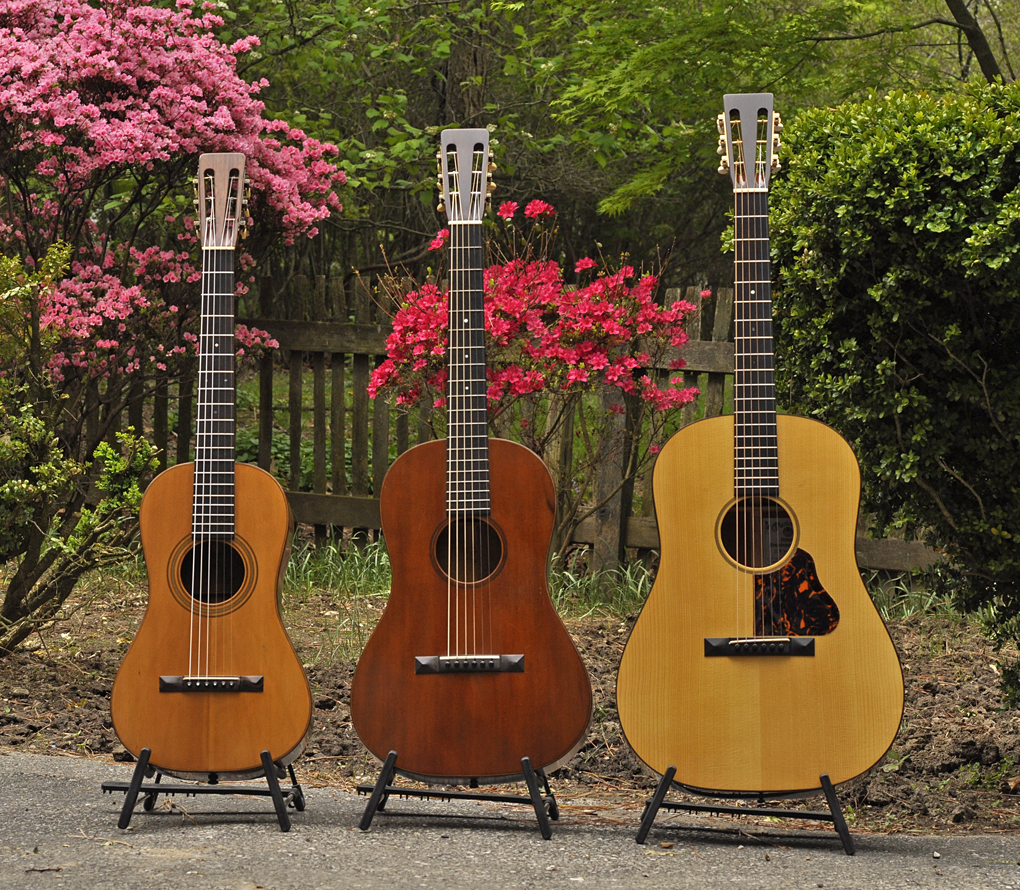
The "Standard" size Ditson Model 1-21, "Concert" size Ditson Model 11, and "Extra Large" (Dreadnaught) size Ditson Model 111 reissue.
Martin's "Ditson Model" guitars, with their wide waisted body shapes reminiscent of early European guitars, were made expressly for the Ditson Stores and came in three sizes, Standard, Concert, and Extra Large.
The Standard Model has a width at the lower bout of 11 1/8"
The Concert Model has a width at the lower bout of 12 3/4"
The Extra Large Model has a width at the lower bout of 15 5/8"
The Extra Large model, requested by Harry Hunt of the Ditson Company, and designed with the help of Martin shop foreman John Deichmann, became known as "the Dreadnaught", and was the first Dreadnaught guitar ever made.
The Ditson Models had their own model designations, and unlike other Martins, their trim level was designated as 1, 2, or 3, but their size was designated by the number of digits, ie. 1, 11 or 111.
All of these regular Ditson Models were made with a spruce top and mahogany back and sides.
Some Ditson Model guitars have either lighter orange tinted tops or dark stained tops. In some years the stained top was an option.
While fan bracing is generally associated with lighter guitars made for gut or nylon strings, the Ditson models have the same style of fan bracing as seen on the koa wood guitars made for the Southern California Music Company, which were originally made to be played with heavier steel strings in the Hawaiian style.
The Models 1, 11 and 111 have dark binding on front, none on the back.
The Models 2, 22 and 222 have white binding front and back.
The earlier Ditson models had bridges supplied by Lyon & Healy of Chicago with raised flat topped squares on the wings rather than the pyramids typical of many of the better vintage Martins.
The 3 and 33 were fancier models which changed a bit through the years. These had pearl inlaid bridges supplied by Lyon & Healy, and the earliest examples had fancy fingerboard inlays. The extra large 333 was catalogued, but none seem to have been made.

Early Ditson Model 2 #144 and Model 22 #160, both from December, 1916

Early Ditson Model 22 #160 from December, 1916 with white binding, standard tinted top and Chicago style bridge, and one from the very last batch of small Martin "Ditson Model" guitars, a Model 11, #565 from January, 1921 with dark binding on top only, optional dark tinted top and standard Martin pyramid bridge. The Model 111 was revived in 1923, and 19 more were made between then and 1930, with standard Martin X bracing replaing the earlier fan bracing.
Ditson also sold guitars which combined the trim levels of regular Martin Styles with the same small, narrow body shape of the Ditson "Standard" size, an example of which is the Style 1-21 shown here. The 1-21 has standard Martin Style 21 trim, including herringbone design marquetry in the rosette around the soundhole and in the center strip on the back. Besides the 1-21, this Ditson size was also available as Ditson Models 1-18, 1-28, 1-30, 1-42, and 1-45.
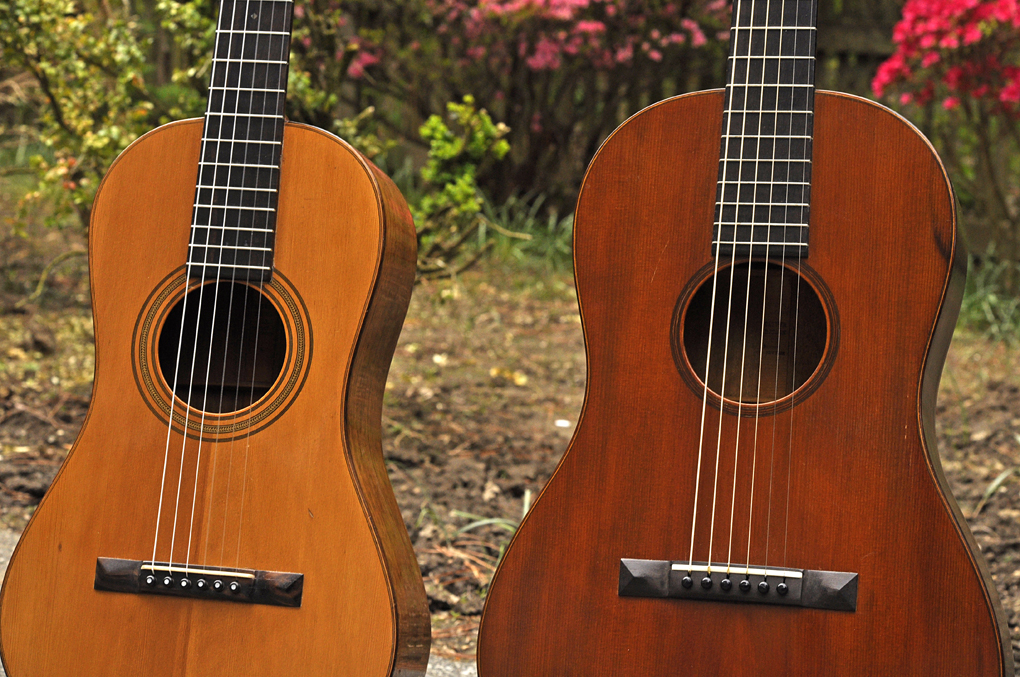
Ditson Model 1-21 #433 from July, 1919 and Model 11 #565 from January, 1921
Ditson was a large music retailer with stores in New York and Boston (and earlier in Philadelphia), and was one of Martin's largest customers, selling guitars and other instruments, including many mandolins. Besides the "Ditson Model" Martins, a large number of regular Martin models, stamped with the C. F. Martin name only, were sold by Ditson. A number of the regular Martin models were also sold by Ditson with the Ditson stamp on the back of the headstock and/or on the inside center strip. And many other models, such as the Empire, were made by other manufacturers for Ditson. So finding an instrument with the Ditson stamp does not necessarily mean you've found a "Ditson Model" Martin, or even an instrument that was made by Martin at all.
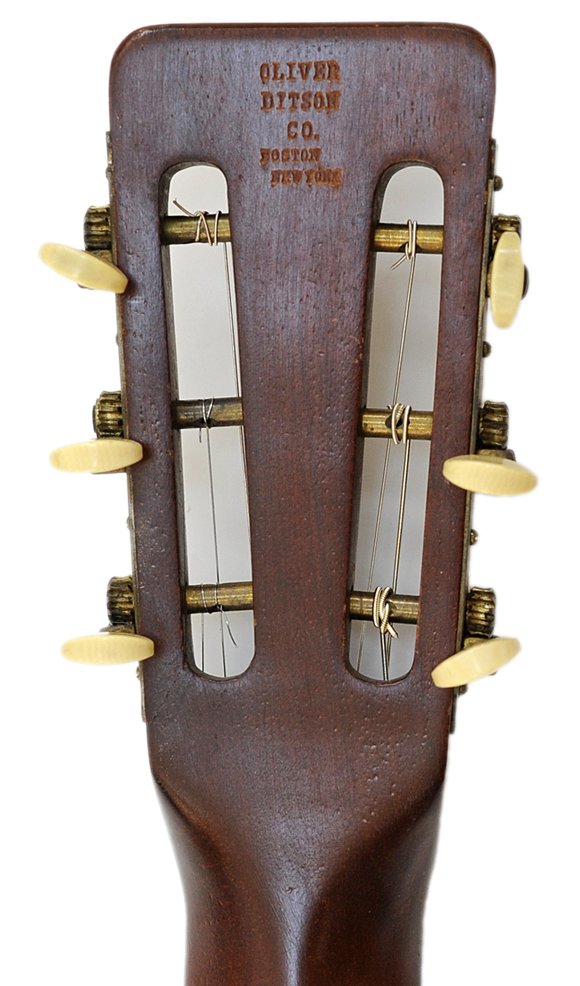
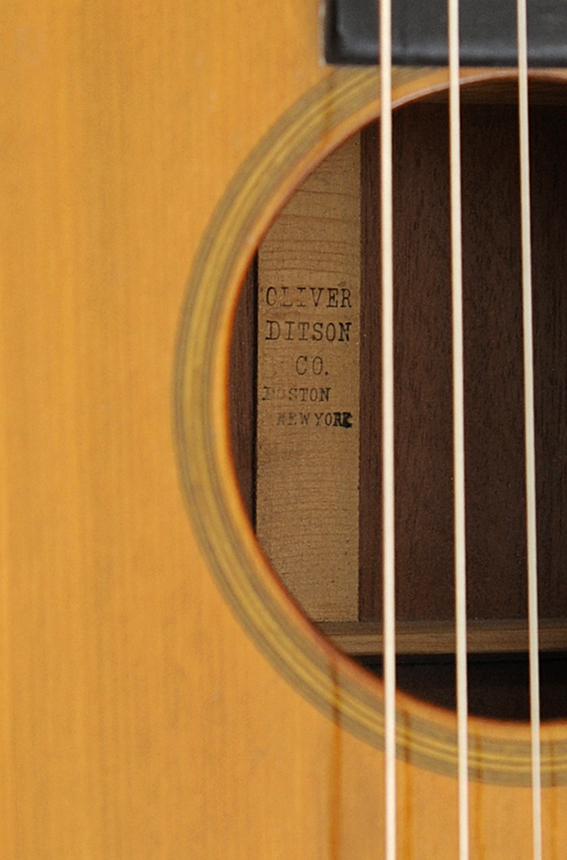
1916 Ditson Model 22 with Oliver Ditson stamps.
During the boom years of the Hawaiian craze, as Martin was struggling to keep up with demand, Martin purchased "Chicago Style" bridges supplied by Lyon & Healy, which were used on the Ditson models.

Ditson Standard Model Dimensions:
Width at the upper bout, 8 7/16"
Width at waist, 7 1/8"
Width at the lower bout, 11 1/8"
End to bridge, 4 9/16"
Bridge depth, 15/16"
Bridge to soundhole, 4 1/8"
Soundhole, 3 9/16"
Soundhole to 12th fret, 4 1/2"
Ditson Concert Model Dimensions:
Width at the upper bout, 9 7/8"
Width at waist, 8 1/2"
Width at the lower bout - 12 3/4"
End to bridge, 5 13/16"
Bridge depth, 15/16"
Bridge to soundhole, 4"
Soundhole, 3 9/16"
Soundhole to 12th fret, 4 9/16"
C.F. Martin 1918 000-42
In 1918, Martin made their first two Style 42 guitars in the relatively new and larger 000 size. While one of the two was a rather conventional Style 42 in the 000 size, this 000-42 was special ordered by the Ditson Company in 1918 in the style of Ditson's new Dreadnaught guitars, which were built for Hawaiian style playing with steel strings. That makes this guitar a rare example of an extremely early 000 size Martin built for steel strings, as well as a rare example of a Martin built for steel strings with an ivory pyramid style bridge. As was true of the early Martin Dreadnaught, and all of Martin's early Hawaiian steel string guitars built for both the Ditson Company and The Southern California Music Company, this guitar was built with fan braces. This guitar was also special ordered with a cloud shaped pickguard inlaid into the top.
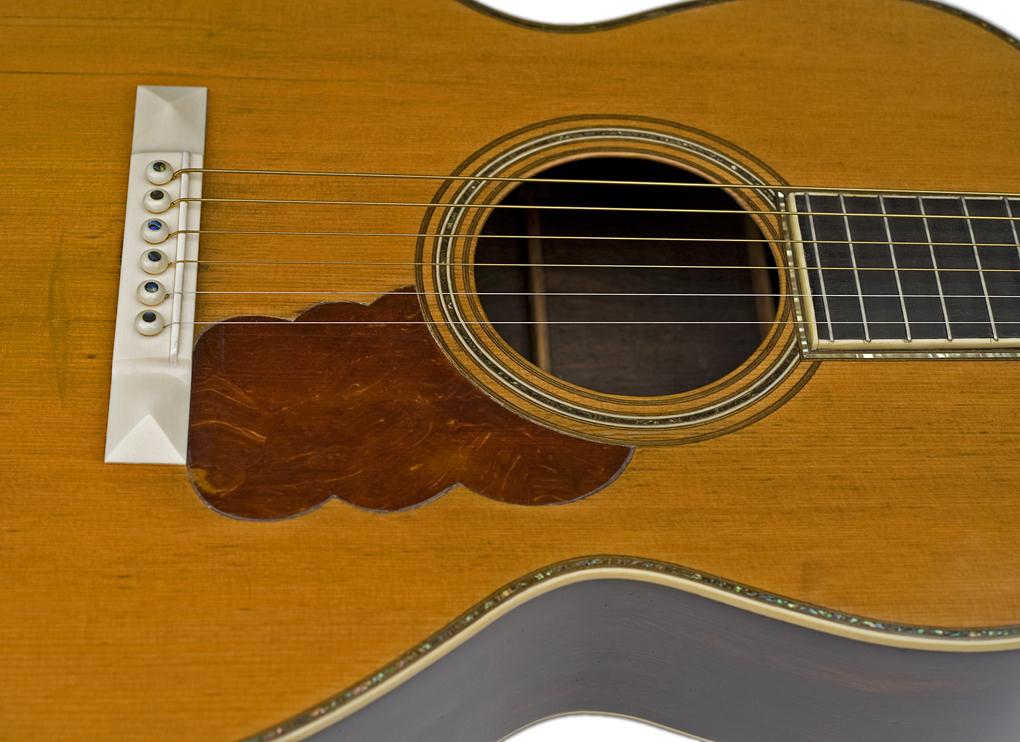

The "Standard" size Ditson Model 1-21, "Concert" size Ditson Model 11, and "Extra Large" (Dreadnaught) size Ditson Model 111 reissue.
Martin's "Ditson Model" guitars, with their wide waisted body shapes reminiscent of early European guitars, were made expressly for the Ditson Stores and came in three sizes, Standard, Concert, and Extra Large.
The Standard Model has a width at the lower bout of 11 1/8"
The Concert Model has a width at the lower bout of 12 3/4"
The Extra Large Model has a width at the lower bout of 15 5/8"
The Extra Large model, requested by Harry Hunt of the Ditson Company, and designed with the help of Martin shop foreman John Deichmann, became known as "the Dreadnaught", and was the first Dreadnaught guitar ever made.
The Ditson Models had their own model designations, and unlike other Martins, their trim level was designated as 1, 2, or 3, but their size was designated by the number of digits, ie. 1, 11 or 111.
All of these regular Ditson Models were made with a spruce top and mahogany back and sides.
Some Ditson Model guitars have either lighter orange tinted tops or dark stained tops. In some years the stained top was an option.
While fan bracing is generally associated with lighter guitars made for gut or nylon strings, the Ditson models have the same style of fan bracing as seen on the koa wood guitars made for the Southern California Music Company, which were originally made to be played with heavier steel strings in the Hawaiian style.
The Models 1, 11 and 111 have dark binding on front, none on the back.
The Models 2, 22 and 222 have white binding front and back.
The earlier Ditson models had bridges supplied by Lyon & Healy of Chicago with raised flat topped squares on the wings rather than the pyramids typical of many of the better vintage Martins.
The 3 and 33 were fancier models which changed a bit through the years. These had pearl inlaid bridges supplied by Lyon & Healy, and the earliest examples had fancy fingerboard inlays. The extra large 333 was catalogued, but none seem to have been made.

Early Ditson Model 2 #144 and Model 22 #160, both from December, 1916

Early Ditson Model 22 #160 from December, 1916 with white binding, standard tinted top and Chicago style bridge, and one from the very last batch of small Martin "Ditson Model" guitars, a Model 11, #565 from January, 1921 with dark binding on top only, optional dark tinted top and standard Martin pyramid bridge. The Model 111 was revived in 1923, and 19 more were made between then and 1930, with standard Martin X bracing replaing the earlier fan bracing.
Ditson also sold guitars which combined the trim levels of regular Martin Styles with the same small, narrow body shape of the Ditson "Standard" size, an example of which is the Style 1-21 shown here. The 1-21 has standard Martin Style 21 trim, including herringbone design marquetry in the rosette around the soundhole and in the center strip on the back. Besides the 1-21, this Ditson size was also available as Ditson Models 1-18, 1-28, 1-30, 1-42, and 1-45.

Ditson Model 1-21 #433 from July, 1919 and Model 11 #565 from January, 1921
Ditson was a large music retailer with stores in New York and Boston (and earlier in Philadelphia), and was one of Martin's largest customers, selling guitars and other instruments, including many mandolins. Besides the "Ditson Model" Martins, a large number of regular Martin models, stamped with the C. F. Martin name only, were sold by Ditson. A number of the regular Martin models were also sold by Ditson with the Ditson stamp on the back of the headstock and/or on the inside center strip. And many other models, such as the Empire, were made by other manufacturers for Ditson. So finding an instrument with the Ditson stamp does not necessarily mean you've found a "Ditson Model" Martin, or even an instrument that was made by Martin at all.


1916 Ditson Model 22 with Oliver Ditson stamps.
During the boom years of the Hawaiian craze, as Martin was struggling to keep up with demand, Martin purchased "Chicago Style" bridges supplied by Lyon & Healy, which were used on the Ditson models.

Ditson Standard Model Dimensions:
Width at the upper bout, 8 7/16"
Width at waist, 7 1/8"
Width at the lower bout, 11 1/8"
End to bridge, 4 9/16"
Bridge depth, 15/16"
Bridge to soundhole, 4 1/8"
Soundhole, 3 9/16"
Soundhole to 12th fret, 4 1/2"
Ditson Concert Model Dimensions:
Width at the upper bout, 9 7/8"
Width at waist, 8 1/2"
Width at the lower bout - 12 3/4"
End to bridge, 5 13/16"
Bridge depth, 15/16"
Bridge to soundhole, 4"
Soundhole, 3 9/16"
Soundhole to 12th fret, 4 9/16"
C.F. Martin 1918 000-42
In 1918, Martin made their first two Style 42 guitars in the relatively new and larger 000 size. While one of the two was a rather conventional Style 42 in the 000 size, this 000-42 was special ordered by the Ditson Company in 1918 in the style of Ditson's new Dreadnaught guitars, which were built for Hawaiian style playing with steel strings. That makes this guitar a rare example of an extremely early 000 size Martin built for steel strings, as well as a rare example of a Martin built for steel strings with an ivory pyramid style bridge. As was true of the early Martin Dreadnaught, and all of Martin's early Hawaiian steel string guitars built for both the Ditson Company and The Southern California Music Company, this guitar was built with fan braces. This guitar was also special ordered with a cloud shaped pickguard inlaid into the top.

earlymartin.com
To See Robert Corwin's Classic Photography of Folk and Roots Musicians, visit:
For Information on Photography for
Exhibition, Publication, CD's, Promotion, Web Pages, Tour Books,
to Purchase Photographic Prints, or
If You Have Questions About An Early Martin Guitar:
e-mail: Robert Corwinentire site copyright ©1998 through 2010 Robert Corwin/Photo-Arts. All rights reserved.